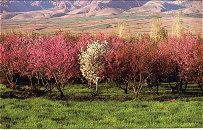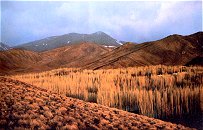|
Khorassan is the easternmost province of northern Iran and its name means, "Where the Sun rises". Ancient Khorassan, which once included parts of Afghanistan, Turkmenistan and Uzbekistan, was mostly destroyed by the invading Mongols and earthquakes have destroyed much of what was left behind by the Mongols. Most of Khorassan province is mountainous; however, there are many fertile valleys and the province produces large quantities of fruit, nuts, sugar beet and cotton.
Khorassan is the largest Iranian province and has a surface area of some 300,000 square kilometres (115,830 square miles), but over half its population is centred around Mashhad and Neishabur. The area around these two cities is known for the quality of its turquoise, and turquoise has been a major industry here for centuries.
Mashhad

View of the Holy Precinct, Mashhad
Mashhad is Iran's holiest city, visited each year by over 12 million pilgrims. Mashhad literally means the Place of Martyrdom, and it is very sacred to Shi'ites as the place where the eighth grandson of the Prophet Mohammed, Imam Reza, died in 817.
Before his death in 809, the Caliph Harun al-Rashid divided the Abbasid Empire into two, giving half to each of his two sons. In 816, Caliph Ma'mun, ruler of the eastern region, wanted to make the Eighth Imam his heir and invited him to travel to the capital, Merv (near the present day Mary, in the Republic of Turkmenistan). While resting in the village of Sanabad, Imam Reza died suddenly after eating some grapes. Caliph Ma'mun had the Imam buried in Sanabad beside the tomb of his own father, Harun al-Rashid. The story spread that the Imam had been poisoned by the Caliph, and his tomb, known as Mashhad, soon became a Shi'ite pilgrimage site.
Mashhad became the capital of Khorassan province in the 15th century, when Shah Rokh the son of Tamerlane enlarged the mausoleum and his wife Gohar Shad commissioned the building of a mosque next to it.
During the Shi'ite Safavid Dynasty, Mashhad became one of the most important Shi'ite pilgrimage centres, as the holy cities of Mecca, Kerbala and Najaf, were under Ottoman Sunnite domination.
In 1736 Nader Shah, although a Sunni himself, established his capital at Mashhad. He made generous donations to the town and the mausoleum.
Under Reza Shah, Mashhad was modernised and several wide avenues were built in the old quarter as well as a circular boulevard around the Holy Precinct.
Today Mashhad is the second biggest industrial centre in the country and its economic importance is reflected in the bustling activity of its streets.
|


